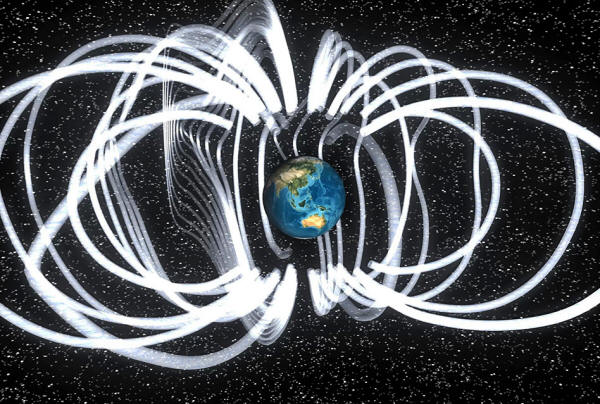|

by Elizabeth Howell
January 30,
2019
from
Space Website
Spanish version

A NASA visualization of
Earth's
magnetic fields.
Credit: NASA
Goddard
Space Flight Center
Conceptual Image Lab
Earth's north magnetic pole is so out of whack that scientists need
to update the global magnetic-field model they released only four
years ago.
Could that be a sign that
the
magnetic pole will flip soon?
The World Magnetic Model (WMM)
- the name of the updated representation of the magnetic field of
Earth - is expected to be released no earlier than Jan. 30. That's
about two weeks later than planned, with the delay due to the
government shutdown, according to
a report in Nature.
The magnetic pole is moving erratically out of the Canadian
Arctic and
toward Siberia so unpredictably
that it took scientists by surprise.
That 2015 update was
supposed to remain valid until 2020, Arnaud Chulliat, a
geomagnetist at the University of Colorado Boulder and the
National Oceanic and Atmospheric Administration's (NOAA)
National Centers for Environmental Information, told Nature.
It's no news that the pole is moving...
Long-term records from
London and Paris (kept since 1580) show that the north magnetic pole
moves erratically around the rotational north pole over periods of a
few hundred years or longer, Ciaran Beggan, a geophysicist
with the British Geological Survey who is involved in WMM updates,
told us in an email.
He cited a 1981 study (The
Direction of the Earth's Magnetic Field at London - 1570-1975)
from the journal Philosophical Transactions of the Royal
Society of London.
But what's really catching attention is the acceleration in
movement. Around the mid-1990s, the pole suddenly sped up its
movements from just over 9 miles (15 kilometers) a year to 34 miles
(55 kilometers) annually.
As of last year, the pole
careened over the international date line toward the Eastern
Hemisphere.
The chief cause of the movement comes from the Earth's
liquid-iron
outer core, which is also
called the "core field." Smaller factors also affect the movement.
Those influences include
magnetic minerals in the crust and upper mantle (especially for
local magnetic fields) and electric currents created by seawater
moving through an "ambient magnetic field," according to the
2015 report of the WMM.
"One of the reasons
we can update the map is that the European Space Agency launched
a set of highly accurate magnetic-field satellites in 2013,"
said Beggan, referring to Swarm.
"We have a superb data set from which we can make very good
magnetic-field maps and update them every six to 12 months,"
Beggan added.
"We noticed that the
specification of the WMM was not being met in the high-latitude
region around the pole, as the error exceeded 1 degree of grid
angle on average.
This triggered us to
examine whether it was worth issuing a new update."
Flipping out
What's more, the core field appears to be weakening - which may be a
sign that the planet's magnetic field will flip...
To better understand how
that would happen, here's how the core field works, according to
Ronald Merrill, an emeritus professor of Earth and space
sciences at the University of Washington, who spoke to a sister site
Live Science.
One easy way to
imagine the field is to think of a bar magnet that runs through
Earth's center and has a north pole and a south pole, said
Merrill, who was not involved in the new WMM research.
That magnet is
strong, representing roughly 75 percent of the intensity of
Earth's magnetic field at the surface.
Of course, a bar magnet is not a perfect representation - it's
actually electric currents that generate the Earth's magnetic
field - but the model makes it easier to imagine what's
happening to Earth, Merrill added.
Specifically, the
"bar magnet" is not only moving, but also getting weaker, by
roughly 7 percent every 100 years.
As for the other 25 percent of the magnetic field, Merrill said
that's generated from another field, which you can picture as
another moving bar magnet.
Here's an interesting
bit:
As the central
bar magnet loses intensity, this second weaker magnetic
field, generates more influence on Earth's global magnetism.
"And that's
what's causing this field to move in the direction [of
Siberia]," Merrill told Live Science.
Earth's north and
south poles periodically swap locations, with
the last flip happening about 780,000 years ago. (The poles also
weakened temporarily and rapidly about 41,000 years ago, Beggan
added, but never underwent a full flip.)
A 2018 study (Earth's
Magnetic Field is probably Not Reversing) in the
journal Proceedings of the National Academy of Sciences
suggested that Earth's magnetic field got weaker before the big
changeover.
While any magnetic-field flip would still be thousands of years
away, the effects could be profound on technology, if similar to
today’s technology.
This is because the
weaker magnetic field would be somewhat poorer at shielding
Earth against the
solar wind (the constant stream
of charged particles emanating from the sun) and
cosmic rays (blasts of
radiation from deep space).
Magnetic compasses
would not be as accurate, and satellites that monitor the
weather or carry telecommunications signals could be disrupted,
said Monika Korte, head of GFZ Potsdam's working group on
geomagnetic field evolution in Germany.
"Regarding
increased radiation, that would go along with decreased
shielding, [but] it seems that the atmosphere would still
provide sufficient shielding at Earth's surface that humans
and animals would not be significantly affected," she told
us in an email.
"However, all the effects we currently only see during
strong solar/geomagnetic storms would likely increase and
occur... during moderate solar activity," she added.
"This includes
satellite outages or damage to satellites, increased
radiation doses on long-distance aircraft and
the ISS [International
Space Station], [and] distortions of telecommunication and
GPS signals."
Ongoing monitoring of
the Earth's geomagnetic field (which includes the pole) will
continue after the WMM release, principally through the
European Space Agency Swarm mission,
Korte said.
But she noted that
measuring the north magnetic pole's position is a challenge.
That's because the
pole is located in a remote area and the measurement of Earth's
magnetic field is influenced by all magnetic-field sources -
including the magnetic fields found in Earth's atmosphere (the
ionosphere and magnetosphere).
"It will depend
on the future magnetic field change, which we cannot
predict, if another update to the model out of the usual
schedule might be required," she added.
The next update to the
WMM after this year's is expected early in 2020, Beggan said.
You can read more about
the WMM
here...
| 

